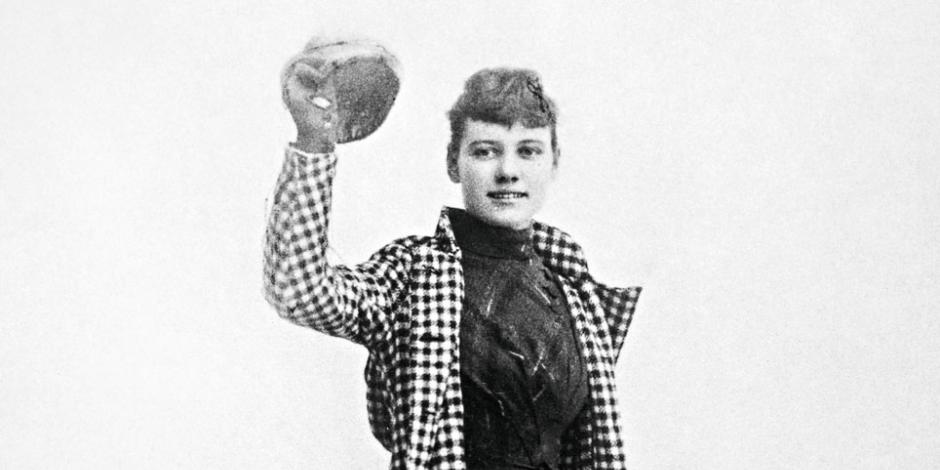Starten Sie den Audio-Text
Mit dem Audio-Player können Sie sich den Text anhören. Darunter finden Sie das Transkript.
Nellie Bly was a pioneer of investigative journalism, yet her own life was just as sensational as anything she wrote about. Listen to Eccentric Life to find out more.
Nellie Bly was born Elizabeth Jane Cochran on May 5, 1864, in Pennsylvania. Her father was a judge and landowner, and the family lived in comfort until his sudden death in 1870. Left without a willTestamentwill, his wife and youngest children had little to live on.
In 1880, the mother moved to Pittsburgh, where Elizabeth hoped to earn her own living, but well-paid work was difficult to find for young women. In 1885, she read in an article in the Pittsburgh Dispatch — “What Girls Are Good For” — that women should stay at home to have children and do housework. furiouswütendFurious, she wrote an anonymous letter to the editor. He was so impressed by the letter that he published it and, after meeting her, offered her a writing job.
As was typical of women newspaper writers at the time, Elizabeth used a pen namePseudonympen name and her articles appeared under the bylineAutorenzeilebyline Nellie Bly. From the beginning, Bly lived by her own maxim: “Energy rightly applied and directed will to accomplishzustande bringenaccomplish anything.” She began reporting on the city’s poor and quickly earned a reputationRufreputation as a talented and pioneering investigative journalist. Her critical writing did, however, cause problems for the Dispatch. After an advertiser complained about her stories, she was moved back to the “women’s pages”.
Bly was unhappy about this and, in 1886, became the newspaper’s correspondentBerichterstatter(in)correspondent in Mexico. Her reports about political corruption and the poverty there angered the Mexican government and she was forced to leave.
In 1887, Bly left Pittsburgh for New York to work for Joseph Pulitzer’s New York World. (The publisher is famous today for posthumously founding the Pulitzer Prize for outstanding US journalism.) Soon after starting her new job, she got herself to commiteinweisencommitted to the insane asylumIrrenhausinsane asylum on Blackwell Island. Her articles to exposeenthüllenexposing the terrible conditions and mistreatmentMisshandlung, falsche Behandlungmistreatment of its inmateInsasse, Insassininmates led to an investigation and important asylum reforms, and made Bly a respected name in New York journalism.
On November 14, 1889, she set off around the world — to see if she could beat the time taken by Phileas Fogg, the fictional hero of Jules Verne’s adventure novel Around the World in Eighty Days (first published in French in 1872).
As news of Bly’s daringwagemutigdaring trip spread, she was greeted along the way by to cheerjubelncheering crowds. It was not her usual sort of hard-hittingkritisch, knallharthard-hitting journalism, but readers followed Bly’s journey enthusiastically.
She traveled through many countries, including England, France (where she met Verne), Italy, Ceylon (present-day Sri Lanka), Singapore, Hong Kong, and Japan — completing her journey 72 days, 6 hours, 11 minutes, and 14 seconds after she had left New Jersey. Her return to New York was accompanied by brass bandBlaskapellebrass-band parades and fireworks. On the back of the huge interest in her 24,899-mile (40,000-kilometer) journey, she wrote the bestseller Around the World in Seventy-Two Days (1890), which established her reputation as a writer at the age of just 26.
Bly retired from journalism in 1895, when she married millionaire industrialist Robert Livingston Seaman. After his death in 1904, Bly was hit by financial problems and she returned to journalism, having lost none of her natural curiosity and skill as a writer. She even reported from the front lines during World War I, and was working for the New York Evening Journal when she died of pneumoniaLungenentzündungpneumonia in 1922, aged 57.
Neugierig auf mehr?
Dann nutzen Sie die Möglichkeit und stellen Sie sich Ihr optimales Abo ganz nach Ihren Wünschen zusammen.



